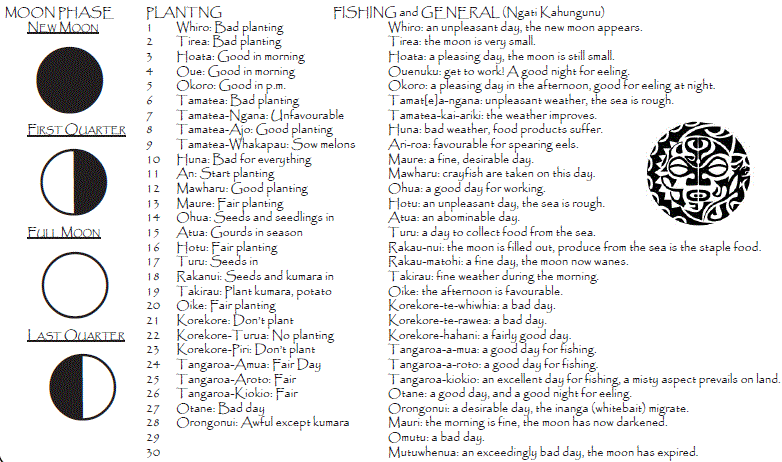Maori Lunar Calendar
The Maori Calendar was passed down orally from generation to generation and related to a traditional form of horticulture that was dependent on a relatively small range of crops, usually planted in different sites each year. Contrary to popular opinion, Maori horticulture did not always produce prolific crops. It usually consisted of one major crop each year which often fell victim to drought or insect damage. However, there is very little doubt about the effect of the moon on crops and it was this knowledge that was passed down. The planting calendar varies from tribe to tribe.
The maramataka divided the traditional Maori year into 12 lunar months. The word marama means both the moon and the lunar month – a lunar month is the 29 and a half days between successive new moons, and normally straddles two calendar months. Maori needed a system that matched lunar months with the solar year – a lunar year is around 11 days shorter. Some tribes listed 13 months in their lunar year, indicating that one month was occasionally added to account for the extra period of time. Those tribes which had only 12 months would have used a different system to account for the extra time. The months were commonly listed numerically: May–June was Te Tahi (the first), June–July was Te Rua (the second), and so on. Each month also had its own name, which sometimes varied between tribes. Tatakangahau of Maungapahatu, a member of Ngai Tuhoe, provided the ethnographer Elsdon Best with these names and descriptions:
The new moon determined the start of the lunar month, which lasted 29 and a half days. Rather than referring to the days of the month, Maori spoke of nights, and each night had its own name. Generally, Whiro was the first night of the new moon and Mutuwhenua was the last. Some nights were considered unlucky for planting and fishing, while others were favourable. Names of the nights – There are a number of tribal variations relating to the months and nights of the moon.

Maori Planting Moon Calendar
| Moon Phase | Day | Planting | Fishing and General (Ngāti Kahungunu) |
| New Moon | 1 | Whiro: Bad planting | Whiro: an unpleasant day, the new moon appears. |
| 2 | Tireā: Bad planting | Tireā: the moon is very small. | |
| 3 | Hoata: Good in morning | Hoata: a pleasing day, the moon is still small. | |
| 4 | Oue: Good in morning | Ouenuku: get to work! A good night for eeling. | |
| 5 | Okoro: Good in p.m. | Okoro: a pleasing day in the afternoon, good for eeling at night | |
| 6 | Tamateā: Bad planting | Tamate(e)ā-ngana: unpleasant weather, the sea is rough. | |
| 7 | Tamateā-Ngana: Unfavourable | Tamateā-kai-āniki: the weather improves. | |
| First Quarter | 8 | Tamateā-Āio: Good planting | Huna: bad weather, food products suffer. |
| 9 | Tamateā-Whakapau: Sow melons | Ari-roa: favourable for spearing eels. | |
| 10 | Huna: Bad for everything | Maure: a fine, desirable day. | |
| 11 | An: Start planting | Mawharu: crayfish are taken on this day. | |
| 12 | Mawharu: Good planting | Ohua: a good day for working. | |
| 13 | Maure: Fair planting | Hotu: an unpleasant day, the sea is rough. | |
| Full Moon | 14 | Ohua: Seeds and seedlings in | Atua: an abominable day. |
| 15 | Atua: Gourds in season | Turu: a day to collect food from the sea. | |
| 16 | Hotu: Fair planting | Rākau-nui: the moon is filled out; produce from the sea is the staple food. | |
| 17 | Turu: Seeds in | Rākau-matohi: a fine day, the moon now wans. | |
| 18 | Rākanui: Seeds and kumara in | Tākirau: fine weather during the morning | |
| 19 | Tākirau: Plant kumara, potato | Oike: the afternoon is favourable. | |
| Last Quarter | 20 | Oike: Fair Planting | Korekore-te-whiwhiā: a bad day. |
| 21 | Korekore: Don’t plant | Korekore-te-rawēa: a bad day. | |
| 22 | Korekore-Turu: No planting | Korekore-hahanui: a fairly good day. | |
| 23 | Korekore-Piri: Don’t plant | Tangaroa-a-mua: a good day for fishing. | |
| 24 | Tangaroa-Amua: Fair Day | Tangaroa-a-roto: a good day for fishing. | |
| 25 | Tangaroa-Aroto: Fair | Tangaroa-kioio: an excellent day for fishing, a misty aspect prevails on land. | |
| 26 | Tangaroa-Kioio: Fair | Otane: a good day, and a good night for eeling. | |
| 27 | Otane: Bad day | Orongonui: a desirable day, the inanga (whitebait) migrate. | |
| 28 | Orongonui: Awful except kumara | Mauri: the morning is fine, the moon has now darkened. | |
| 29 | Omuku: a bad day | ||
| 30 | Mutuwhenua: an exceedingly bad day, the moon has expired. |
Each month was represented by a star or stars. According to one Ngati Kahungunu authority, ‘without exception, stars were the ariki (controllers, heads) of these months’.2 For example, for many Maori the year began in May or June with the appearance of Matariki (the Pleiades constellation).
1. Pipiri (May–June). All things on earth are contracted because of the cold; likewise man.
2. Hongonui (or Hongongoi, June–July). Man is now extremely cold and kindles fires before which he basks.
3. Here-turi-koka (July–August). The scorching effect of fire is seen on the knees of man.
4. Mahuru (August–September). The earth has now acquired warmth, as have vegetation and trees.
5. Whiringa-a-nuku (September–October). The earth has now become quite warm.
6. Whiringa-a-rangi (October–November). It has now become summer, and the sun has acquired strength.
7. Hakihea (November–December). Birds are now sitting in their nests.
8. Kohi-tatea (December–January). Fruits are now ripe and man eats of the new food of the season.
9. Hui-tanguru (January–February). The foot of Ruhi (a summer star) now rests upon the earth.
10. Poutu-te-rangi (February–March). The crops are now harvested.
11. Paenga-whawha (March–April). All straw is now stacked at the borders of the plantations.
12. Haratua (April–May). Crops are now stored in pits. The tasks of man are finished.
Plant kumaras with the head (i e the sprout end) facing east and slightly higher than the other end Start in early September and plant through October and November. – Best days for planting kumaras and potatoes are Oue, Rakanul, Takirau and Orongonui. – Many Maori believed that if the moon was due north at sunset on good planting days, then a bumper crop was assured. – Seeds should be planted on Turu and Rakanui – Always transplant before dusk. Plant rows from east to west. – Gourds should be planted at the full moon but nothing else Planters note :- rain is likely to occur on the days after the new and full moon

